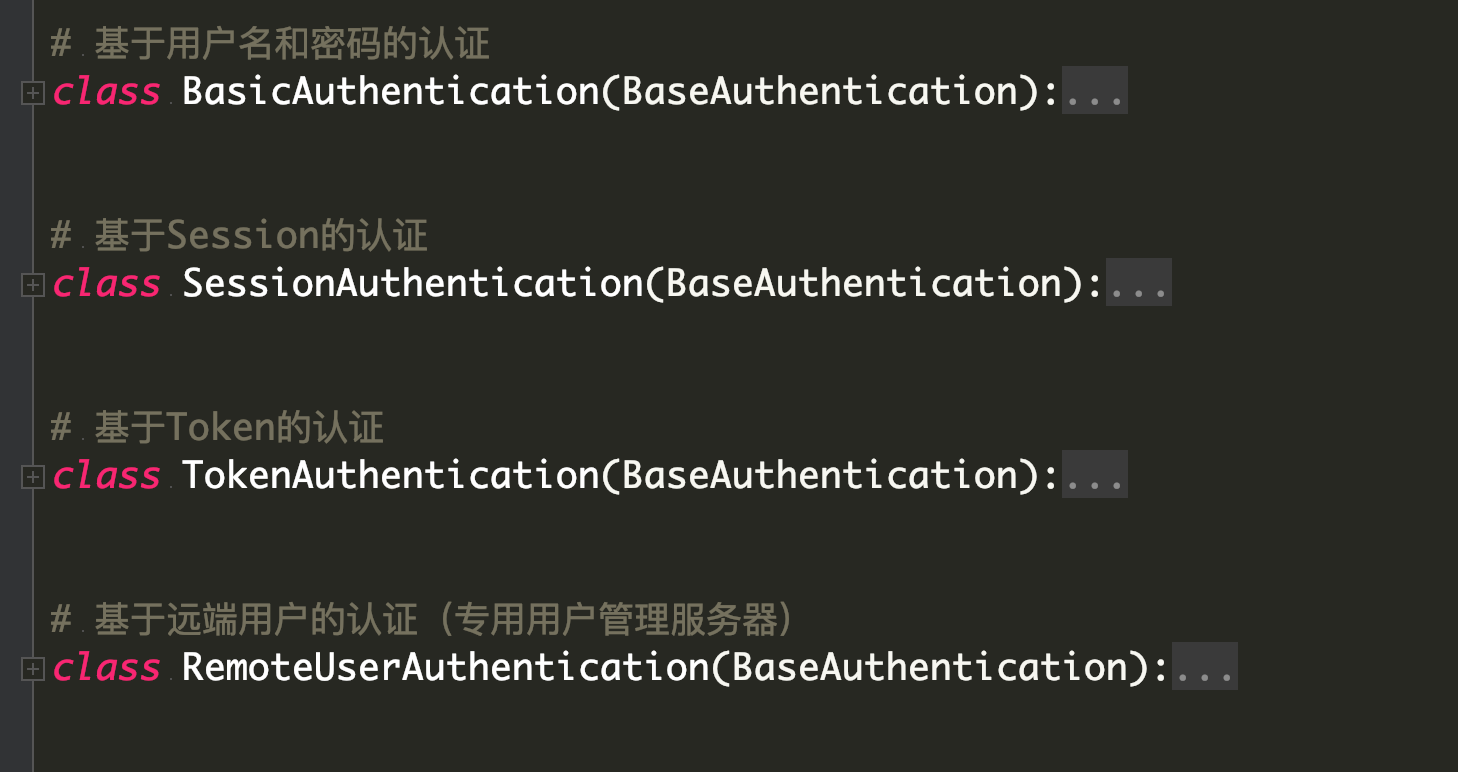Django REST framework认证、权限、频率
身份验证是将传入请求与一组标识凭据(例如请求来自的用户或其签名的令牌)相关联的机制。然后 权限 和 限制 组件决定是否拒绝这个请求。
认证:所谓认证就是身份的认证,是否登陆,确定你是谁
权限:确定你哪些接口可以访问
频率:就是访问接口的频率了
三个组件会一个,就都会了, 他们都的代码形式都一样
认证
DRF自带认证方案
REST framework 提供了一些开箱即用的身份验证方案,并且还允许你实现自定义方案。

我们自己动手实现一个基于Token的认证方案:
自定义Token认证
流程大致就是,用户登陆成功,生成一个随机字符串也就是token,在数据库里生成那条token同时返回给用户,下次访问时用户拿着token和数据库里的做比对,这样就实现了验证功能
开始:
表
定义一个用户表和一个保存用户Token的表:
class UserInfo(models.Model): username = models.CharField(max_length=16) password = models.CharField(max_length=32) type = models.SmallIntegerField( choices=((1, '普通用户'), (2, 'VIP用户')), default=1 ) class Token(models.Model): user = models.OneToOneField(to='UserInfo') token_code = models.CharField(max_length=128)
定义登陆视图
def get_random_token(username): """ 根据用户名和时间戳生成随机token :param username: :return: """ import hashlib, time timestamp = str(time.time()) m = hashlib.md5(bytes(username, encoding="utf8")) m.update(bytes(timestamp, encoding="utf8")) return m.hexdigest() class LoginView(APIView): """ 校验用户名密码是否正确从而生成token的视图 """ def post(self, request): res = {"code": 0} print(request.data) username = request.data.get("username") password = request.data.get("password") user = models.UserInfo.objects.filter(username=username, password=password).first() if user: # 如果用户名密码正确 token = get_random_token(username) models.Token.objects.update_or_create(defaults={"token_code": token}, user=user) res["token"] = token else: res["code"] = 1 res["error"] = "用户名或密码错误" return Response(res)
定义认证的类
utils.py:
from rest_framework.authentication import BaseAuthentication from rest_framework.exceptions import AuthenticationFailed class MyAuth(BaseAuthentication): def authenticate(self, request):
# 注意:这里只验证这几个请求方法,并且注意GET请求方法用GET或query_params if request.method in ["POST", "PUT", "DELETE"]: request_token = request.data.get("token", None) if not request_token: raise AuthenticationFailed('缺少token') token_obj = models.Token.objects.filter(token_code=request_token).first() if not token_obj: raise AuthenticationFailed('无效的token') return token_obj.user.username, None else: return None, None
视图(局部)级别认证
class CommentViewSet(ModelViewSet): queryset = models.Comment.objects.all() serializer_class = app01_serializers.CommentSerializer authentication_classes = [MyAuth, ]
全局级别认证
# 在settings.py中配置 REST_FRAMEWORK = { "DEFAULT_AUTHENTICATION_CLASSES": ["app01.utils.MyAuth", ] }
权限
只有vip才能查看的内容
自定义一个权限类
utils.py:
# 自定义权限 from rest_framework.permissions import BasePermission class MyPermission(BasePermission): message = 'VIP用户才能访问' def has_permission(self, request, view): """ 自定义权限只有VIP用户才能访问 """ # 因为在进行权限判断之前已经做了认证判断,所以这里可以直接拿到request.user if request.user and request.user.type == 2: # 如果是VIP用户 return True else: return False
视图级别配置
class CommentViewSet(ModelViewSet): queryset = models.Comment.objects.all() serializer_class = app01_serializers.CommentSerializer authentication_classes = [MyAuth, ] permission_classes = [MyPermission, ]
全局级别设置
# 在settings.py中设置rest framework相关配置项 REST_FRAMEWORK = { "DEFAULT_AUTHENTICATION_CLASSES": ["app01.utils.MyAuth", ], "DEFAULT_PERMISSION_CLASSES": ["app01.utils.MyPermission", ] }
限制
DRF内置了基本的限制类,首先我们自己动手写一个限制类,熟悉下限制组件的执行过程。
自定义限制类
在throttles.py中:
from rest_framework.throttling import BaseThrottle
VISIT_RECORD = {} # 自定义限制 class MyThrottle(BaseThrottle): def __init__(self): self.history = None def allow_request(self, request, view): """ 自定义频率限制60秒内只能访问三次 """ # 获取用户IP ip = request.META.get("REMOTE_ADDR") timestamp = time.time() if ip not in VISIT_RECORD: VISIT_RECORD[ip] = [timestamp, ] return True history = VISIT_RECORD[ip] self.history = history history.insert(0, timestamp) while history and history[-1] < timestamp - 60: history.pop() if len(history) > 3: return False else: return True def wait(self): """ 限制时间还剩多少 """ timestamp = time.time() return 60 - (timestamp - self.history[-1])
视图使用
class CommentViewSet(ModelViewSet): queryset = models.Comment.objects.all() serializer_class = app01_serializers.CommentSerializer throttle_classes = [MyThrottle, ]
全局使用
# 在settings.py中设置rest framework相关配置项 REST_FRAMEWORK = { "DEFAULT_AUTHENTICATION_CLASSES": ["app01.utils.MyAuth", ], "DEFAULT_PERMISSION_CLASSES": ["app01.utils.MyPermission", ] "DEFAULT_THROTTLE_CLASSES": ["app01.utils.MyThrottle", ] }
使用内置限制类
from rest_framework.throttling import SimpleRateThrottle class VisitThrottle(SimpleRateThrottle): scope = "xxx" def get_cache_key(self, request, view): return self.get_ident(request)
全局配置
# 在settings.py中设置rest framework相关配置项 REST_FRAMEWORK = { "DEFAULT_AUTHENTICATION_CLASSES": ["app01.utils.MyAuth", ], # "DEFAULT_PERMISSION_CLASSES": ["app01.utils.MyPermission", ] "DEFAULT_THROTTLE_CLASSES": ["app01.utils.VisitThrottle", ], "DEFAULT_THROTTLE_RATES": { "xxx": "5/m", } }